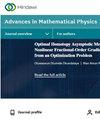磁场和黏性耗散作用下Eyring-Powell纳米流体在多孔拉伸圆柱体上的流动动力学
IF 1.1
4区 物理与天体物理
Q3 PHYSICS, MATHEMATICAL
引用次数: 0
摘要
本文利用Cattaneo-Christov理论研究了在磁场和黏性耗散作用下,eyling - powell纳米流体在多孔拉伸圆柱体上的流动动力学。为了研究热泳力和布朗运动的影响,考虑了两相(Buongiorno)模型。因此,制定了控制流动问题的非常非线性的偏微分方程,通过相关相似变量将其转换为偏微分方程,并利用MATLAB R2018a软件中的R-K-45积分方案和射击技术进行求解。因此,数值模拟结果表明,Eyring-Powell流体、曲率、速比等参数均有提高纳米流体速度的倾向。纳米流体温度随磁性、曲率、耗散加热和热泳参数的增加而增加。此外,普朗特数、Eyring-Powell流体、流速比、热松弛时间和孔隙参数对纳米流体温度的影响逐渐减弱。因此,多孔介质在系统冷却方面合理且成功地控制了纳米流体温度以及整个热系统。随着施密特数、磁性、曲率、耗散热、热泳、布朗运动和溶质弛豫时间等参数的增大,浓度曲线逐渐下降。表面摩擦系数随流体、磁性和曲率参数的增大而增大,而多孔介质和速度比参数则相反。磁性、曲率、Eyring-Powell流体、速度比和耗散加热参数对Nusselt和Sherwood数的影响越来越大,尽管两者都随着多孔介质参数的减小而减小。此外,在一些极限情况下,将当前结果与先前发表的文献的表面摩擦系数进行比较,得到了很好的一致性。本文章由计算机程序翻译,如有差异,请以英文原文为准。
Flow Dynamics of Eyring–Powell Nanofluid on Porous Stretching Cylinder under Magnetic Field and Viscous Dissipation Effects
The current paper scrutinized the flow dynamics of Eyring–Powell nanofluid on porous stretching cylinder under the effects of magnetic field and viscous dissipation by employing Cattaneo–Christov theory. In order to study impacts of thermophoretic force and Brownian motion, the two-phase (Buongiorno) model is considered. As a consequence, very nonlinear PDEs that govern flow problem were formulated, transformed into ODEs via relevant similarity variables, as well as tackled by utilizing R-K-45 integration scheme along with the shooting technique in the MATLAB R2018a software. Consequently, the numerical simulations reveal that Eyring–Powell fluid, curvature, velocity ratio parameters have the propensity to raise nanofluid velocity. Nanofluid temperature shows an increasing pattern with magnetic, curvature, dissipative heating, and thermophoresis parameters. Besides, Prandtl number, Eyring–Powell fluid, velocity ratio, thermal relaxation time, and porous parameters indicate the declining impact against the nanofluid temperature. Hence, the porous medium reasonably and successfully managed nanofluid temperature as well as the overall thermal system in terms of system cooling. The concentration profile gets fall down with escalating values of Schmidt number, magnetic, curvature, dissipative heating, thermophoresis, Brownian motion, and solutal relaxation time parameters. Moreover, coefficient of the skin friction gets rise for larger values of Eyring–Powell fluid, magnetic and curvature parameters however porous medium and velocity ratio parameters reveal the opposite trends on it. The magnetic, curvature, Eyring–Powell fluid, velocity ratio, and dissipative heating parameters indicate increasing impacts on both Nusselt and Sherwood numbers even though both and get cut down with the porous medium parameter. Moreover, an excellent and sound agreement was attained up on comparing coefficients of the skin friction for the current result against that of previously published literatures under some limiting cases.
求助全文
通过发布文献求助,成功后即可免费获取论文全文。
去求助
来源期刊

Advances in Mathematical Physics
数学-应用数学
CiteScore
2.40
自引率
8.30%
发文量
151
审稿时长
>12 weeks
期刊介绍:
Advances in Mathematical Physics publishes papers that seek to understand mathematical basis of physical phenomena, and solve problems in physics via mathematical approaches. The journal welcomes submissions from mathematical physicists, theoretical physicists, and mathematicians alike.
As well as original research, Advances in Mathematical Physics also publishes focused review articles that examine the state of the art, identify emerging trends, and suggest future directions for developing fields.
 求助内容:
求助内容: 应助结果提醒方式:
应助结果提醒方式:


